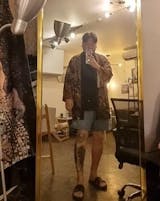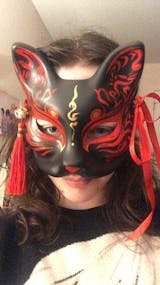I am not the type of person to write reviews but here it goes.
I really needed the clothes for an unexpected party but I chose the fast delivery option and I should say I’m impressed by their fast delivery. The product matches the pictures displayed and I’m impressed by the quality. Kudos to Eiyo Kimono.
Filters
Sukajan Jacket 101: The Japanese Bomber Jacket
What is a Sukajan Jacket
Japanese souvenir jackets, known as sukajan in Japan, are well-known for their eye-catching patterns. Since worldwide superstars have been seen wearing them on a daily basis, the jacket's appeal has skyrocketed in recent years. The sukajan jacket has been worn by celebrities such as Ryan Gosling, Harry Styles, Katy Perry, and Kanye West and has appeared on the runways of Dior, Louis Vuitton, and Yves Saint Laurent. But, unknown to its many lovers, the sukajan took a circuitous route from military-occupied Japan during World War II to becoming one of the most-seen fashion pieces on the planet.
They frequently used rayon and silk, and they were occasionally produced from leftover silk salvaged from military parachutes. Jackets were transported back to the United States as a literal keepsake and were occasionally purchased as a present to give to relatives and friends. The jacket has embroidered and traditional motifs comparable to the American Bomber Jacket.
The term's history is still debated. Some attribute it to a combination of sky dragon and jacket in Japan, while others attribute it to the name Yokosuka. Yokosuka was where American troops were stationed during the war. The names of the garments — Yokosuka and jyanpa — reflect this history (Japanese for "jumper" or "jacket"). The sukajan gained popularity among high-end stores and Hollywood celebrities in the mid-2010s. Sukajan is still prized today for its "unique" nature, military style, and rebellious message.
What does Sukajan mean?
Souvenir Jacket, also known as Sukajan, originated in Japan after World War II when soldiers were stationed in the Battle of the Pacific. Following the war, the US forces began using traditional Japanese hand-stitched patterns to sew motifs into the backs of their shirts to memorialize their time in Japan. Sukajan's most popular designs are dragons, cherry blossoms, trees, and nature. They picked local artwork for the soldier that ranged from traditional map iconography to photos of geisha girls.
Other common names for Sukajan
- Sukajan Jacket
- Sukajan Bomber Jacket
- Japanese Bomber Jacket
- Souvenir Jacket
- Japanese Souvenir Jacket
The History of Sukajan
In the 1960s, American trends and fashions were incorporated into Japanese culture. Many Japanese teenagers at the time admired the American preppy image and preferred to dress in traditional American clothing. While souvenir jackets were originally designed for American soldiers, they were ironically adopted by a Japanese audience as well. Those who refused to adapt to the Americana-obsessed Ametora trend opted for the Sukajan as a statement piece and an act of protest. Working-class teenagers adopted the style, and it became a symbol of resistance in postwar Japan.
As the jackets were returned to the United States and circulated around Europe, many outside the military establishment sought and valued them. The jackets became a symbol of counterculture, with rock musicians like Mick Jagger wearing them on tour. The use of the jacket by pop culture giants and celebrities in recent years has helped to reintroduce the design into popular fashion.
The sukajan was revived in the mid-2010s, with a major surge in popularity among high fashion stores and Hollywood celebrities, making the jacket the 'defining fashion piece' of 2017, according to Menswear Style magazine.
What is the most popular EmbroideredAnimal on Sukajan, and what does it Represent?
- Tiger- (blessing & peace)
- Ryū (dragon) – (wisdom, power, balance, freedom & good luck)
- Snake – (protection, good luck & strength)
- Koi fish – (courage, patience & success)
- Tortoise – (good luck, longevity, and support)
- Phoenix – (symbolizes great luck and peace)
What to Consider while Purchasing a Sukajan
Choosing between a vintage and a new sukajan is a good place to start. For starters, a pre-owned jacket is unquestionably more one-of-a-kind. Each stitch, especially if it is an actual military souvenir jacket, would be imbued with a tale particular to its original owner. However, some practical difficulties with buying vintage include the larger amount of labor required to preserve the jacket, as well as its typically higher price.
Why are the Jackets so Expensive?
Traditional sukajan are designed to be a little tighter fitting than other coats. Cuffs and hems are generally elasticized at the wrist and waist, and the body is often tapered to fit. As the sukajan is designed to be the focal point of the costume, you should just wear a t-shirt or a single layer below it.
Keep in mind that these coats may be pretty expensive, so verify your money account before going shopping. Synthetic or mass-produced sukajan can range in price from 4,000 to around 30,000, while boutique sukajan can cost anywhere from 15,000 to upwards of 80,000. These rates are determined by the cloth, the amount and detail of the embroidery, and, of course, the business. Some retailers also sell reversible sukajan, which feature different patterns on both sides of the garment.
How to Wash Sukajan?
The first thing you should realize before purchasing any sukajan is that these are not coats designed to be worn for warmth or weather protection. If not properly cared for, genuine satin jackets might suffer from water damage, but rayon/synthetic jackets can survive a lot of wear and tear. Because the embroidery will unravel over time, a fast fashion version may only last one to two seasons, but a somewhat more expensive one may endure four to six seasons of intensive wear. If you're searching for a winter-ready sukajan, seek one with a zipped-in liner or room for a zippered sweatshirt below.
Some people may be afraid to wash the Yokosuka Jacket at home because we may end up ruining the most vital aspect of this item of apparel. You might check the Washing Instructions on the Jacket to see whether we can wash that specific piece of apparel at home. If the label reads "Hand wash" or "Mechanical action minimized," you might wash the jacket in our home washing machine. On the other hand, if the label says "Dry," we should not wash the jacket in our home washing machine. To avoid fraying, wash it in cold water with non-abrasive detergent on a mild machine setting.
The Take-Away
Sukajan is traditionally designed to accommodate your body type. Ideally, your jacket should be tailored to your frame, with an elasticized cuff and hem that are just right—not too tight nor too loose. Because the embroidery normally takes up a big amount of the jacket, you may want to keep the rest of your clothing clean and simple to avoid drawing attention away from the pattern's stunning artwork. While the souvenir jacket now has a fad, it has already shown to have long-term appeal.






















































































